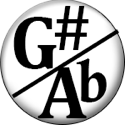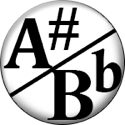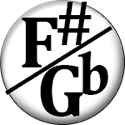Understanding the B String Gap

Understanding the B String Gap Hi, I'm Grey and this is Hub Guitar. One of the most frustrating things about learning the guitar is learning to compensate for the gap between the G and B strings. Why do we have a gap? The guitar is tuned mostly in fourths. From E to A is a fourth; from A to D is a fourth. From D to G is a fourth. But when we go from G to B it's only a third. Returning from B to E is another fourth. The advantage of this tuning is that we have E on both sides, so it's somewhat symmetrical. If we kept going in fourths, the 2nd string would be tuned to C and the first string would be tuned to F and the whole thing would get a little out of control. The disadvantage is that the intermediate guitar learner starts to feel that there is suddenly a missing fret between strings G and B. Take any pattern that uses two or more strings. Start it on the "C" of the 6th string and compare that to the same pattern starting on the "C" of the 5th string. It's the same. And if you start it on the "C" of the fourth string it's also the same. But if you try to play such a pattern from the "C" of the 3rd string, it must cross onto the B string, and the shape of the pattern must change. The notes played on the B string must all be raised by one fret, so the pattern will LOOK different but SOUND the same. This is something that you'll start to really grasp intuitively over time as your playing advances. You'll find yourself automatically adjusting the patterns you play as the cross over to the B string and beyond, and intuitively the guitar will make alot more sense once you can see where this boundary is and how it affects everything you play. I'm going to show you some of the logic of how this works by taking a drop 2 C maj7 chord and moving it across the strings with you. Ultimately, the more often you take patterns and move them across the strings, the faster you'll learn to visualize this happening. And also, it's a great thing to do because you need to be able to see those relationships anyways. [Examples] So that's the dreaded B string gap. This frustrates every guitar player at some point, but with some thoughtful practice you can learn to visualize the notes as they move along the guitar, both up and down strings–and jumping across strings.
One mark of the advancing guitar player is that they begin to come to grips with the B string gap, that oddity of guitar tuning that causes fretboard shapes and patterns to appear different when they cross over the B string.
First, a primer on guitar tuning is in order.
Guitar Tuning System
The guitar has six strings. One feature of the guitar is that both the highest and lowest strings are tuned to the same note, E, and this lends a semi-symmetrical feeling to the guitar neck. If we play the note on the lowest string, fret III it is exactly two octaveAn interval of twelve semitones. Octaves are very important in music theory.s below that of the IIIrd fret on the highest string.
This symmetry makes the guitar a logical instrument in some ways. And without this, we wouldn’t really be able to use barre chords as much because there would be too many different notes resulting from a single finger pressing every string on the same fret. Unfortunately, there is no way to divide that two octaves evenly by any single interval across six strings. If we started on E and tuned the guitar to fourths (5 half-steps difference between each string), we would have:
All Fourths Tuning
| E | A | D | G | C | F |
This goes over the two octaves and creates a weird result.
So if we use an intervalAn interval refers to any melodic distance between any two pitches. greater than a fourth we'll be even less able to reach our desired two octave range, because we'll overshoot it. And most of them would have even weirder results.
All Thirds Tuning
If we do major thirds, we get this:
| E | G# | B# (C) | E | G# | B# (C) |
This is almost like a weird open tuning for augmented chords. It’s not that useful.
So it seems that to create a two-octave range between the 6 strings, we need to use some combination of fourths and thirds. We cannot consistently use the same interval.
So the compromise that evolved was to tune the guitar to what is now considered standard tuning.
Standard Tuning
| E | A | D | G | B | E |
In this tuning scheme, we have a tuning of fourths for the lowest four strings, and then there’s suddenly a third from G to B, before we have another fourth taking us back to E—two octaves above the lowest string.
Some decisions of this tuning, you may find, are arbitrary. For example, the same intervals could have been used, but one step lower:
Standard Tuning, One Step Lower
| D | G | C | F | A | D |
Or, the third could be moved from the third and second strings to the second and first strings:
Four Fourths and a Third
| E | A | D | G | C | E |
Overall, standard tuning stands for a number of reasons:
- The low strings, tuned to EADG, match the tuning for the classical upright bass, which was also the inspiration for the tuning of the bass guitar.
- Standard tuning consists of all natural notes, allowing for easier playing in common keys such as C major or G major.
- Standard tuning allows for a fix link two octave chromatic scale to be played from the lowest to highest string. When playing melodies, notes tend to move in intervals of smaller than one octave, so they should all be within reach of each other.
- Most chords can be played without unreasonable difficulty.
- The two-octave distance between the 6th and 1st strings makes barre chords easier.
- Now that this tuning is so widely used, all guitar players start here.
How this Affects Guitar Players
Intermediate and advanced guitar players will begin to hear the notes before they play them. This hearing is made more difficult by the fact that one of the strings is tuned to a different interval. Suddenly, crossing over the line of the B string means that the pattern visually does not match the other strings. This happens when trying to copy any pattern from the bottom four strings (EADG) to any position where it will move onto the B string (or the high E string, for that matter). As a result of the B string’s tuning in a third, the high E string is also different when compared to the third string.
Visualizing the Gap
One great way to visualize how the gap works is to practice playing chords, scales or arpeggios (structures) that span across two, three, or four strings and compare them across different string sets.
Take for example the drop 2 major 7th chord.
This chord has a root, a fifth, a major 7th, and a major 10th (the third, up an octave).
Move this structure on to the middle four strings, and you get this shape:
Note that it is still the exact same configuration in terms of intervals. But because the b string of the guitar is tuned to a third instead of a fourth, that note appears one semitone or fret higher, but actually it’s the same note.
Now let’s move it to the top four strings.
Here things get even more interesting. The root and fifth maintain the same original shape (C to G). However, the 7th now crosses over to the B string, which we know is one half-step lower, so it must be "raised" by one fret in order to be equal to the same interval it had been before. In addition, the highest note, E, also appears to be raised! Although the 1st and 2nd strings are a fourth apart from each other, that major 10th which crosses from the C on the fourth string, over the boundary of the B string, and onto the E string, has also changed its shape.
Put it into Practice
Practice and visualize patterns such as intervals, octaves, closed chords, single octave scales and arpeggios, and move them across to different string sets. When you find that crossing this boundary feels effortless and subconscious, you will know you are moving towards a new level of guitar playing.
 As the creator of Hub Guitar, Grey has compiled hundreds of guitar lessons, written several books, and filmed hundreds of video lessons. He teaches private lessons in his Boston studio, as well as via video chat through TakeLessons.
As the creator of Hub Guitar, Grey has compiled hundreds of guitar lessons, written several books, and filmed hundreds of video lessons. He teaches private lessons in his Boston studio, as well as via video chat through TakeLessons.











